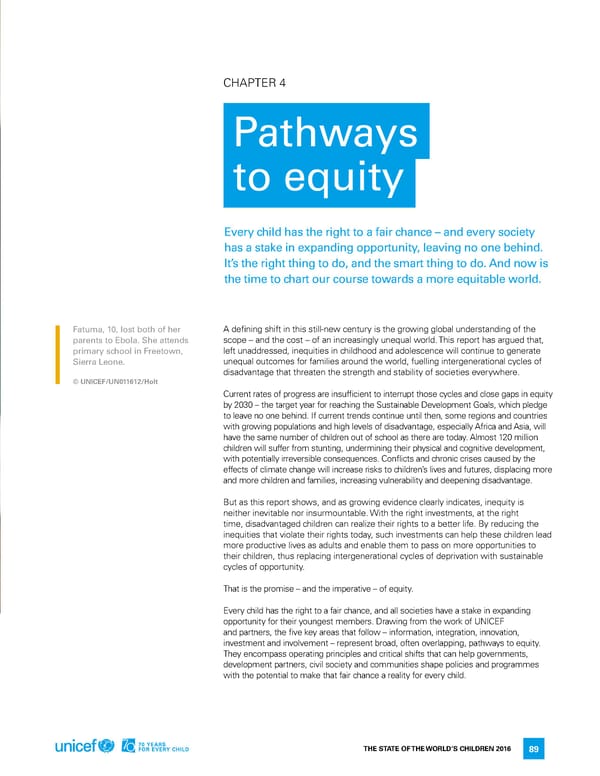ChaPTer 4 Pathways to equity Every child has the right to a fair chance – and every society has a stake in expanding opportunity, leaving no one behind. It’s the right thing to do, and the smart thing to do. And now is the time to chart our course towards a more equitable world. Fatuma, 10, lost both of her a defining shift in this still-new century is the growing global understanding of the parents to Ebola. She attends scope – and the cost – of an increasingly unequal world. This report has argued that, primary school in Freetown, left unaddressed, inequities in childhood and adolescence will continue to generate Sierra Leone. unequal outcomes for families around the world, fuelling intergenerational cycles of disadvantage that threaten the strength and stability of societies everywhere. © UNICEF/UN011612/Holt Current rates of progress are insufficient to interrupt those cycles and close gaps in equity by 2030 – the target year for reaching the Sustainable development Goals, which pledge to leave no one behind. if current trends continue until then, some regions and countries with growing populations and high levels of disadvantage, especially africa and asia, will have the same number of children out of school as there are today. almost 120 million children will suffer from stunting, undermining their physical and cognitive development, with potentially irreversible consequences. Conflicts and chronic crises caused by the effects of climate change will increase risks to children’s lives and futures, displacing more and more children and families, increasing vulnerability and deepening disadvantage. But as this report shows, and as growing evidence clearly indicates, inequity is neither inevitable nor insurmountable. With the right investments, at the right time, disadvantaged children can realize their rights to a better life. By reducing the inequities that violate their rights today, such investments can help these children lead more productive lives as adults and enable them to pass on more opportunities to their children, thus replacing intergenerational cycles of deprivation with sustainable cycles of opportunity. That is the promise – and the imperative – of equity. every child has the right to a fair chance, and all societies have a stake in expanding opportunity for their youngest members. drawing from the work of UniCef and partners, the five key areas that follow – information, integration, innovation, investment and involvement – represent broad, often overlapping, pathways to equity. They encompass operating principles and critical shifts that can help governments, development partners, civil society and communities shape policies and programmes with the potential to make that fair chance a reality for every child. The STaTe of The World’S Children 2016 89
 70 Years for Every Child Page 106 Page 108
70 Years for Every Child Page 106 Page 108